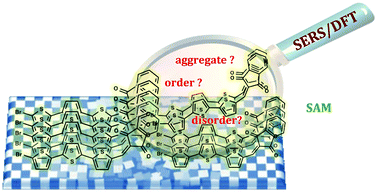Combined SERS/DFT studies of push–pull chromophore self-assembled monolayers: insights into their surface orientation†
Abstract
Having clear and deep information on the surface/interface of deposited molecules is of crucial importance for the development of efficient optoelectronic devices. This paper reports on a joint experimental/theoretical hybrid approach based on Raman spectroscopy in order to provide information on the orientation of push–pull chromophores deposited onto a gold surface. In addition, several parameters can strongly control or impede the orientation of such molecules on the surface such as: the molecular structure, the surface itself, the method of deposition and the solvents used. From this approach, additional information has been highlighted such as perpendicularly depositing the molecule on the surface, the bithiophene compounds displaying more solvent effects compared to terthiophene molecules and so on. According to the results, the joint SERS/DFT study proves to be an effective tool for probing the arrangement of push–pull chromophores and selecting the right experimental conditions to tune the surface properties.



 Please wait while we load your content...
Please wait while we load your content...